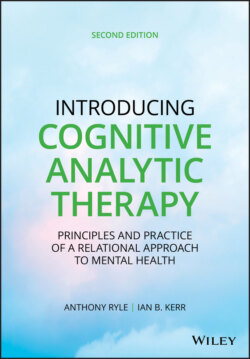Читать книгу Introducing Cognitive Analytic Therapy - Anthony Ryle - Страница 45
3
The CAT Model of Development of the Self Summary
ОглавлениеCognitive Analytic Therapy (CAT) is based upon a fundamentally relational and social concept of the Self that has important implications for psychotherapy. This concept is based on clinical research and, to varying extents, on consideration of emerging understandings from the fields of developmental and infant psychology, neuroscience, genetics, sociology, and evolutionary psychology, as well as other models of psychotherapy. In CAT a mature “phenotypic” Self is understood to be the result of a process of development through which an original “genotypic” Self interacts and communicates with caregivers and others. This process occurs on the basis of an inherent human capacity and need for intersubjectivity and relationality, in the context of likely genetic and temperamental variation. Importantly, the Self also “internalizes” the social meanings and cultural values implicit in these interactions. From a Vygotskian perspective, “internalization” is seen to involve meaning‐making and sign‐mediation and, as it proceeds, to result in transformation of the psychological structures involved. This results in a considerable cross‐cultural diversity of the Self. Such development takes place optimally, through benign, collaborative “activity,” in the infant's “zone of proximal development.” The CAT model also developed from a consideration of Kellyian personal construct theory, cognitive therapy, and psychoanalytic object‐relations theory, but has diverged increasingly from these in its emphasis on the social formation of mind and Self, based on consideration of recent developmental psychology, Vygotskian activity theory, and Bakhtinian concepts of the dialogic self. The Self is understood in CAT as having developmentally internalized, and as being fundamentally constituted by, a repertoire of reciprocal roles (RRs) and emergent adaptive, coping reciprocal role procedures (RRPs), and as characterized by a varying emergent capacity for agency, self‐reflection, empathic imagination, relationality, executive function, creativity, and, for some, a sense of spirituality. A more complete although tentative definition of the Self from a CAT perspective is offered.
The theory and practice of CAT is based on a clearly defined and radically relational and social concept of the Self. As noted previously, we have deliberately capitalized the concept of “Self” to imply a substantive “organizing construct” while recognizing that this remains a problematic concept requiring careful definition that must remain at present provisional and tentative (see also discussion in Chapter 2). Indeed, its multidimensional nature (extending “from the epigenetic to the existential”) represents a currently insoluble challenge for any model of mental disorder and treatment. Despite lip service paid by mental health professionals of various backgrounds, ranging from the biomedical to the socio‐cultural, to some form of “bio‐psycho‐social” approach, in practice most workers focus, perhaps inevitably, on their own area of interest, to the exclusion of a sustained consideration or attempt at integration of other factors. In this chapter we shall offer an outline of the process by which the Self is understood in CAT to be formed, and outline and consider some of the background factors that play a role in determining and influencing the outcome of that process. The more detailed therapeutic implications of abnormal or damaging development of the Self are considered further in Chapter 4. Some of this background may, again, reasonably be skimmed or read selectively by those more immediately interested in the clinical use of the model.
